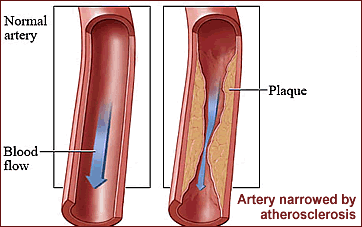Traditional
Risk Factors Predict Cardiovascular Risk in People with HIV
 |
 |
 |
 |
 |
 |
 |
| SUMMARY:
Traditional
risk factors including male sex, family history, smoking,
abnormal blood lipids, and high blood pressure were
among the predictors of atherosclerosis and cardiovascular
events in 2 recently published studies. One analysis
found that certain inflammation biomarkers were associated
with elevated risk, and the other observed that use
of tenofovir
(Viread, also in the Truvada
and Atripla
coformulations) might actually have a protective effect,
but neither saw a link between cardiovascular disease
and lower CD4 cell count. |
|
 |
 |
 |
 |
 |
 |
 |
By
Liz Highleyman
Several studies have shown that people
with HIV have a higher risk of cardiovascular disease and
associated events such as heart attacks compared with the HIV
negative general population. It is not yet clear, however, whether
this is due to HIV infection itself, chronic immune activation
and inflammation, antiretroviral
drugs, a higher prevalence of traditional risk factors, or
some combination of these.
FRAM
Study
As
described in the September
10, 2010 issue of AIDS, Joseph Delaney, Carl Grunfeld,
and fellow investigators with the Fat Redistribution and Metabolic
Change in HIV (FRAM) study looked at an early indicator of cardiovascular
disease, carotid intima-media thickness (IMT).
 Increased
carotid IMT -- or greater thickness of the lining of the carotid
arteries supplying blood to the brain -- is a sign of atherosclerosis,
or buildup of plaque and loss of elasticity in the arteries. Atherosclerosis
of the coronary arteries supplying the heart can lead to a heart
attack, while carotid atherosclerosis is a risk factor for strokes. Increased
carotid IMT -- or greater thickness of the lining of the carotid
arteries supplying blood to the brain -- is a sign of atherosclerosis,
or buildup of plaque and loss of elasticity in the arteries. Atherosclerosis
of the coronary arteries supplying the heart can lead to a heart
attack, while carotid atherosclerosis is a risk factor for strokes.
The FRAM team aimed to identify HIV-related risk factors associated
with increased carotid IMT, including CD4 T-cell count, HIV viral
load, and use of antiretroviral therapy (ART).
This retrospective analysis looked at medical records from 538
HIV positive FRAM participants. A majority (about 70%) were men,
about 40% were African-American, the mean age was 48 years, and
the average estimated duration of HIV infection was 13 years;
almost all were on combination ART. With regard to traditional
cardiovascular risk factors, more than half were current or former
smokers.
All participants had at least 1 carotid artery ultrasound scan.
The researchers focused on IMT in the common carotid (the main
segment of the artery before it forks into 2 branches), the internal
carotid (1 of the 2 branches), and the carotid bulb (the bulging
segment around the bifurcation where the artery forks); prior
research has shown that the
site of measurement can affect likelihood of detecting carotid
artery thickening.
Results
 |
In
a Bayesian mathematical model, predictors of increased IMT
in the common carotid artery included: |
 |
 |
Older
age, black race, systolic and diastolic blood pressure:
all at least 95% probability; |
 |
Lower
high-density lipoprotein (HDL) "good" cholesterol:
85% probability; |
 |
Hispanic
ethnicity: 51% probability. |
|
 |
Of
all the HIV-related factors included in the analysis, only
tenofovir use was a significant predictor (51% probability),
but it was associated with decreased IMT (-0.0094 mm per year
of use). |
 |
Predictors
of increased internal carotid IMT included older age and smoking
(both 100% probability). |
 |
For
internal carotid IMT there were no HIV-related risk factors
above the 50% probability threshold. |
"We
observed an inverse association between duration of tenofovir
use and common carotid IMT," the study authors concluded.
"Whether this association is causal or due to confounding
by indication needs further investigation."
The investigators were unable to explain the apparent modest protective
effect of tenofovir. Participants taking this drug had similar
demographic characteristics, somewhat lower total cholesterol,
but a history of worse HIV disease (lower nadir CD4 cell count,
higher percentage with an AIDS diagnosis).
Inflammation Biomarkers
In the second study, described in the June
19, 2010 issue of AIDS, Emily Ford from the National Institute
of Allergy and Infectious Diseases (NIAID) and colleagues performed
a retrospective case-control study to assess the association between
cardiovascular events and traditional cardiovascular risk factors,
HIV disease, and inflammation.
A growing body of evidence indicates that chronic immune activation
and persistent inflammation contribute to several non-AIDS conditions
-- including cardiovascular disease and non-AIDS cancers -- seen
with increasing frequency as people with HIV survive longer due
to effective ART.
This analysis included HIV positive participants enrolled in National
Institutes of Health clinical protocols between 1995 and 2009.
A total of 52 individuals who experienced an incident (new) cardiovascular
disease event (for example, a heart attack) were matched 2:1 with
HIV positive people without cardiovascular disease.
The researchers measured several biomarkers of inflammation and
immune cell activation in blood serum or plasma and in peripheral
blood mononuclear cells. These included the acute phase inflammation
marker high-sensitivity C-reactive protein (CRP), the coagulation
(thrombosis or clotting) biomarker D-dimer, the endothelial dysfunction
marker soluble vascular cell adhesion molecule-1 (VCAM-1), and
tissue inhibitor of metalloproteinase-1 (TIMP-1).
Results
 |
The
52 case patients with cardiovascular events were significantly
more likely to have traditional risk factors compared with
control subjects, either at baseline or after up to 2 years
of follow-up: |
| |
 |
Smoking:
49% among cases vs 25% among controls; |
 |
Family
history of cardiovascular disease: 30% vs 11%, respectively; |
 |
Abnormal
blood lipids: 87% vs 72%, respectively; |
 |
Higher
total cholesterol; |
 |
Higher
low-density lipoprotein (LDL) "bad" cholesterol; |
 |
Higher
blood glucose. |
|
 |
After
4 months of follow up, HIV viral load was significantly lower
among case patients compared with control subjects (2500 vs
14000 copies/mL). |
 |
CD4
cell count and type or duration of ART, however, did not differ
between the 2 groups. |
 |
Several
inflammation markers were elevated in patients with cardiovascular
events: D-dimer, soluble VCAM-1, TIMP-1, soluble tissue factor,
CD41 cells. |
 |
Levels
of high-sensitivity CRP, however, were similar in both groups. |
 |
The
immune activation markers CD38 and HLA-DR also did not differ
between the groups. |
 |
In
a multivariate analysis adjusting for other factors, smoking,
family history, D-dimer, and glucose remained independent
predictors of cardiovascular disease risk. |
Based
on these findings, the study authors concluded, "In this
cohort, cardiovascular disease risk was related to traditional
cardiovascular disease risk factors and markers of thrombosis
and endothelial damage, but not to high-sensitivity C-reactive
protein or markers of T-cell activation such as CD38/human leukocyte
antigen-DR co-expression."
Taken together, these studies shed more light on factors associated
with cardiovascular disease risk in HIV positive people on ART,
but do not offer definitive answers given that they conflict with
prior research.
Neither of these studies, for example, saw an association between
cardiovascular disease and lower CD4 cell count, contradicting
2
other recent reports indicating that a decline in CD4 count
-- even at relatively high levels -- increased the risk of cardiovascular
disease and heart attacks.
Investigator affiliations:
Delaney study: University of Florida, Gainesville, FL; University
of California, San Francisco, CA; Department of Veterans Affairs,
San Francisco, CA; Department of Biostatistics, University of
Washington, Seattle, WA; Tufts Medical Center, Boston, MA; University
of California, Los Angeles, California, USA.
Ford study: National Institute of Allergy and Infectious Diseases,
National Institutes of Health, Bethesda, MD.
8/31/10
References
JA Delaney, R Scherzer, ML Biggs, C Grunfeld, and others (FRAM
study team). Associations of antiretroviral drug use and HIV-specific
risk factors with carotid intima-media thickness. AIDS
24(14): 2201-2209 (Abstract).
September 10, 2010.
ES
Ford, JH Greenwald, AG Richterman, and others. Traditional risk
factors and D-dimer predict incident cardiovascular disease events
in chronic HIV infection. AIDS 24(10): 1509-1517 (Abstract).
June 19, 2010.
|
|
|
|
 |
|
Stories
of Success in HIV: Proven Interventions for Improving
wareness, Testing, Access to Care, and Treatment of HIV in
Communities of Color.
|
|
|
|
 |
|
Stories
of Success in HIV: Proven
Interventions for Improving wareness, Testing, Access to Care,
and Treatment of HIV in Communities of Color.
|
|
|
